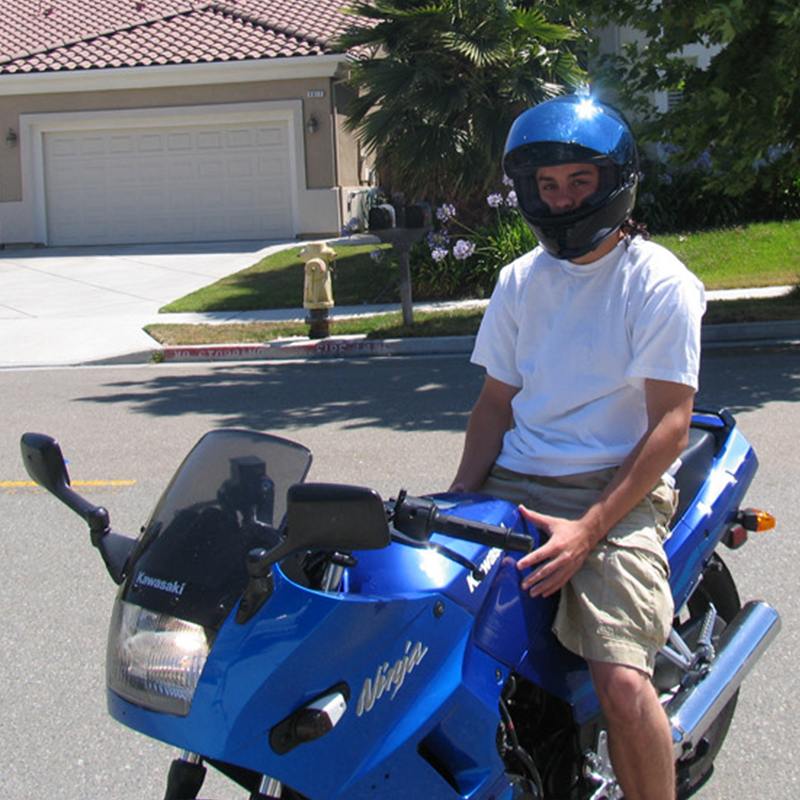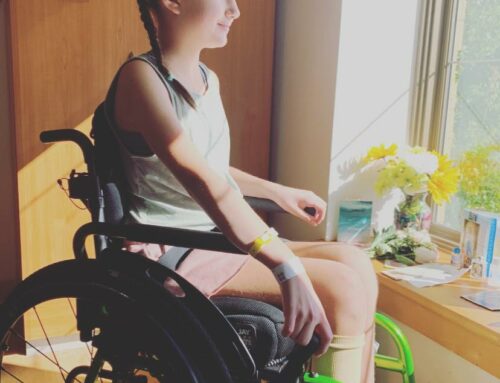When someone suffers a spinal cord injury, the devastating physical effects are evident. The mental and emotional ones are not. Tommy Swarts discusses both.
In 2008 Tommy Swarts was a 20-year-old software developer, working with clients such as Palm Pilot, ScanDisk, Trans Union, and the Golden State Warriors. He also participated in the company’s inline hockey team. “I was having so much fun,” Swarts muses. “And I was growing and learning from everybody I worked with.”
CTRL/ALT/DEL
In short, Swarts paints a picture of a young man living his best life in California’s tech development community; a community that includes a subset of young men with penchants for fast motorcycles.
In August 2008, eight days after Swarts’ 21st birthday, his idyllic California lifestyle came to a crashing halt during one of his weekend motorcycle rides.
“You know, one day I was riding my motorcycle, a Kawasaki Ninja 250, just like every other weekend with my friends,” explains, in his laid-back Cali drawl. The group came out of a canyon, and got behind a vehicle that, seemingly out of nowhere, made a U-turn over a double-yellow line and collided with him.
Chaos; Chaotic News
Swarts was in the emergency room when he was told he was paralyzed. “I remember it was very chaotic; that the doctors poked and prodded me with things, and then as if the chaos stopped, they said, ‘Thomas, you have a lumbar fracture—a burst fracture. It’s most likely you are going to be paralyzed from the waist down, and you will never walk again.’”
Two days later, after the swelling subsided, he had decompression and repair surgery on his L1 disc at Sutter Health Eden Medical Center in Castro Valley, CA transferred to its inpatient rehabilitation department, where he stayed for three months.
“I was very much looking forward to getting home,” Swarts says, but juxtaposed that with a longing to be back in the hospital. “You know, the nurses and therapists knew what they were doing. They were taking care of me, and I was safe.”
Home with Swagger
Swarts’s spinal cord injury is L1 incomplete, and he went home with minimal movement in his lower torso. He also went home with healthy doses of spasticity and nerve pain.
Since Swarts did not have any insurance, he did not receive additional physical therapy. He did, however, receive a large cash settlement from the accident.
(Swarts did later qualify for California’s state Medicaid program, and used some of his settlement money to pay back the state for most of his care).
By his own admission, the combination of money, pain, and idle time was not a good one. He’d go out with friends and present an air of confidence–an “I got this!” swagger from his wheelchair. “Partying, hanging out, not paying attention to what was going on inside me,” he admits today.
False Bravado
Swarts had a roommate at the time, and other friends would remark to him they couldn’t believe how upbeat and optimistic Swarts was; was he really like that? “I was,” says Swarts. “Sadly.”
He explains.
“I was with this group of friends, and I was self-soothing by being optimistic, but I needed the reverberation or my friends to mirror back my optimism,” he says.
But they were getting married, having children, and starting their own lives.
“When they were removed from the equation, I had nobody to convince me that I was OK,” his voice catches.
Swarts, feeling horrible both outside and in, was not financially astute and quickly blew through his money.
Man in the Mirror
“I hit rock bottom,” he says, and he had to move in with his parents.
Swarts couldn’t work as a software developer; sitting for more than two hours was excruciating, and his leg spasms were intense. “I became a recluse and found solace in bed, video games, movies, and TV,” Swarts admits.
It was at this point Swarts began rehabbing his body and mind. His state insurance couldn’t cover physical therapy for his SCI, or his depression, so Swarts did what many could not: he built both programs for himself.
“It took time and personal ‘comprehension,’” he says, but Swarts now sees his self-isolation as a time of positive introspection.
“Looking back,” muses Swarts, “that time enabled me to part the curtains of depression and let in the light of creation.”
“I was abjectly alone—with a broken body, a broken mind, and I became intent on understanding that I did have some flaws and needed to address them,” Swarts admits.
Building Blocks
He started by moving his right ankle. Every day, a few centimeters, for 15 minutes. “I forced myself—I never took a day off, and I started to progress.”
Swarts used his research skills and scoured the internet for techniques, tips, and tools to aid in his physical recovery. As he improved, Tommy began sharing what he learned with others on social media.
Eventually, over a few years, he returned to swimming, something he did competitively before his accident.
Health from Within
Still, he work to on his mental and spiritual self.
He turned to Dr. Daniel G. Amens book, “Change Your Brain Change Your Life,” and The Medical Medium‘s nutritional regimens, two trusted sources which extol the virtues of food and nutrition as methodologies to heal your brain and bodies.
For his emotional recovery, Swarts opened his mind to to Eastern philosophy, which he combined with his Christian upbringing.
Swarts stuck to programs he designed for himself, and continued to share what he learned with the online community. His journey took years, and. By no way was a smooth road. When it became too much, Swarts would take social media breaks.
Sharing is Caring
For a sense of permanence and to share, he created a website. At first, he called it “Tommy Paralyzed,” but after some cajoling from a friend, he recently renamed it, “Tommy Walks Again.” He even shares occasionally on his Youtube channel: https://youtube.com/channel/UCayT1P0L8_F12Um_Y8LGdYQ
Swartz theorizes, “Pain and suffering amount to a spiritual currency, and that while we all go through it in various ways–whether physical pain and/or mental anguish– it can drive us to become spiritually aware.”
Continuing to Flourish
Swarts built back his body, mind and soul to a level where he felt confident applying for jobs. He now operates the seaweed removal boat and tines for Lake Austin, TX, and drives a shuttle limousine for a steakhouse. At first, Swarts says, the pain and spasms were almost impossible to bear, “but the feeling of confidence and success that ‘wow, I made it!’ has made it easier every time.”
And through those connections, Swarts made a connection with a software developer who has invited him to rejoin the coding community.
“I have to study some, brush up,” Swarts laughs.
That shouldn’t be a problem.
The experience depicted here is one individual’s own experience. If you are experiencing anxiety, depression or any mental stress, contact The National Alliance on Mental Illness at 800-950-6264.
Shalieve
Wisdom

Don’t discount your suffering; it helps us understand love.. “The suffering allows us to understand that love is the only thing that matters in the world. That's the only thing that matters.
Remember, “Success is the sum of small efforts, repeated day-in and day-out.” “At first, it was hard for me to do anything, I was stuck in apathy. But I forced myself to do everything for at least 10 minutes.”
Don’t be afraid to take a job again. “Don’t be afraid, or embarrassed as to how much or little you can do. It leads to amazing interactions with people who want us to succeed.”









